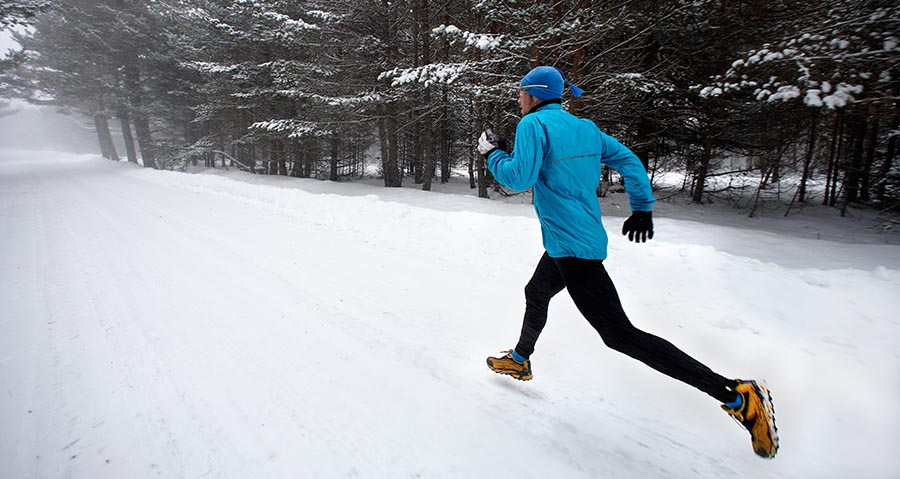Cold Weather's Impact on Workouts
How cold weather influences your performance, body, and gear
It’s obvious how cold weather changes the outdoor environment in wintertime, but it isn’t as apparent how it impacts your performance when training and racing. This article is filled with essential tips for having safe, cold-weather workouts. Because without knowledge and proper preparation, exercising in cold weather can be a dangerous undertaking.
Similar to the affects of running into a headwind, your body needs burn extra energy to stay warm when exercising in freezing temperatures. Because of this, lactate production is increased, making higher intensities more taxing to maintain. In addition, fast-twitch muscle fiber use is increased because your muscle contractions are not as powerful.
On the bright side, because the air is cool, you can regulate your body temperature more effectively than you can in hot weather (if you layer your clothing properly). This makes longer and more productive workouts possible. Plus, the ideal marathon temperature is said to be 41°F (5°C), so remember that non-freezing temperatures can be beneficial for endurance sports.
Essential tips for cold weather workouts
- Stay hydrated
It's common to not drink as much in cold weather, because without the scorching heat you don't feel as thirsty. You still sweat a lot, and lose hydration by breathing as well. Actively avoiding dehydration is very important.
- Wear layers
Wear a base layer of thin, moisture-wicking fabric against your skin, a form-fitting layer of fleece or wool as the next layer (that you can easily remove and put back while in motion), and a shell as the external layer (if necessary). Avoid cotton. It cannot insulate when wet. Keep your head and hands warm, too.
- Don't forget about the sun
A common mistake in the winter is not protecting exposed skin from the sun. When exercising in direct sunlight for extended periods of time, wear sunblock. Using lip balm with SPF protection is recommended, too.
- Eat lots of carbohydrates
When working out in cold weather, your muscles require more energy than in warmer conditions, which may make you tired more quickly. This can be combatted by eating more carbohydrates before, during, and immediately after your workout.
- Stay indoors during extreme cold
When the "Feels like" temperature dips below 15° F (-10° C), consider staying inside. Do an indoor workout instead: core training, aerobic drills, stationary bike, etc. Besides, mixing up your winter training with hot indoor workouts can improve your performance in the cold.
- Pre-workout warm-ups are key
Warm-up routines are beneficial, as they help condition your body for a hard workout, and they can help reduce the likelihood injuries. They're also great in cold weather, because in addition to the other benefits, they help you build up and maintain your core body heat.
- Be cautious during "cool downs"
When you're between higher-intensity intervals or just taking a breather, be wary of cooling down too much when outdoors. Because it's so cold out, you may have a difficult time warming back up. Use a light jogging pace as your baseline for rest intervals to avoid giving up too much of your body heat.
- Shivering is a warning
As your body temperature decreases, you will begin shivering. These involuntary muscle contractions try to generate heat — but they also consume a lot of your energy. If you are unable to stop shivering, terminate the workout and immediately proceed to warmth and shelter. This is why it's a good idea to train on shorter out-and-back routes (or short loops), so you're never far from home.
- Swimmers must take extra precautions
Since the threat of hypothermia is significantly higher due to the conductive properties of water, cold-weather swimmers must be especially vigilant. Layering clothing isn't an option, so wearing a temperature-appropriate wetsuit is key. Shorter swims are also encouraged, as is having a partner nearby to keep an eye on you. Don't hesitate to cut a workout short if you detect numbness, shortness of breath, or other ailments.
Review your cold-weather abilities in your workout history
A great way to plan your winter training is by basing your workouts on previous cold-weather activities. In SportTracks, you can quickly and easily review past workouts, and arrange them by sport and temperature.

Reviewing previous cold-weather workouts will give you a solid idea of the intensities you're capable of in various weather conditions. If you're not presently a SportTracks user, you can sign up for a free 45-day trial and easily import your entire workout history from another platform. SportTracks will automatically add detailed weather data to every GPS workout you have.
Hopefully this article has been helpful! You can learn more about how weather impacts your workouts in our articles about humidity and wind.
| Article written by Sam Mallery, Director of Marketing, Zone Five Software Inc. |


Comments
Small comment on "Stay indoors during extreme cold" - don't let cold stop you. Just dress better with 2 more layers, appreciate that it will be harder and get out there. Lots of benefits to exercising in what "southerners" deem as cold. Just be more prepared.
Great tip about looking at your workouts based on temp - clearly showed that effort was up and speed was slower once below -15C. Burnt 20% more calories for the same amount of time but was 30% slower for the same average distance.
As usual, excellent sports analysis software